Fast-food chain Wendy’s (NASDAQ:WEN) fell short of analysts' expectations in Q1 CY2024, with revenue up 1.1% year on year to $534.8 million. It made a non-GAAP profit of $0.23 per share, improving from its profit of $0.21 per share in the same quarter last year.
Wendy's (WEN) Q1 CY2024 Highlights:
- Revenue: $534.8 million vs analyst estimates of $540.5 million (1.1% miss)
- EPS (non-GAAP): $0.23 vs analyst estimates of $0.21 (8.1% beat)
- Gross Margin (GAAP): 35.3%, in line with the same quarter last year
- Free Cash Flow of $82.63 million, up 77.5% from the previous quarter
- Same-Store Sales were up 0.9% year on year
- Market Capitalization: $4.03 billion
Founded by Dave Thomas in 1969, Wendy’s (NASDAQ:WEN) is a renowned fast-food chain known for its fresh, never-frozen beef burgers, flavorful menu options, and commitment to quality.
Dave was an experienced restaurateur, having been the original head cook at the line of restaurants that would eventually become KFC and a trusted partner to its CEO, Colonel Harland Sanders. After over a decade of successfully managing and growing KFC, Dave sold his stake in the company back to the Colonel, providing the funds for his next venture: Wendy’s.
The inspiration for the new business came from his daughter Melinda, who loved hamburgers and was affectionately known as Wendy. Since those early days, Wendy’s has grown tremendously due to Dave’s determination to create a fast-food experience that stood out.
At the heart of Wendy's success lies its dedication to delivering exceptional meals. From its signature square-shaped burgers to its Frosty ice cream and viral 4 for $4 meal, which bundles a cheeseburger, chicken nuggets, french fries, and a drink, each menu item showcases Wendy's commitment to taste, quality, and value.
Every Wendy’s restaurant promotes a comfortable atmosphere where customers can opt for cozy indoor seating or the convenience of a drive-thru. It’s also embraced technological advancements, having partnered with popular delivery platforms and developing a mobile app, allowing customers to easily place orders, customize meals, and access exclusive offers.
Traditional Fast Food
Traditional fast-food restaurants are renowned for their speed and convenience, boasting menus filled with familiar and budget-friendly items. Their reputations for on-the-go consumption make them favored destinations for individuals and families needing a quick meal. This class of restaurants, however, is fighting the perception that their meals are unhealthy and made with inferior ingredients, a battle that's especially relevant today given the consumers increasing focus on health and wellness.
Sales Growth
Wendy's is larger than most restaurant chains and benefits from economies of scale, giving it an edge over its smaller competitors.
As you can see below, the company's annualized revenue growth rate of 6.2% over the last five years was mediocre , but to its credit, it opened new restaurants and grew sales at existing, established dining locations.
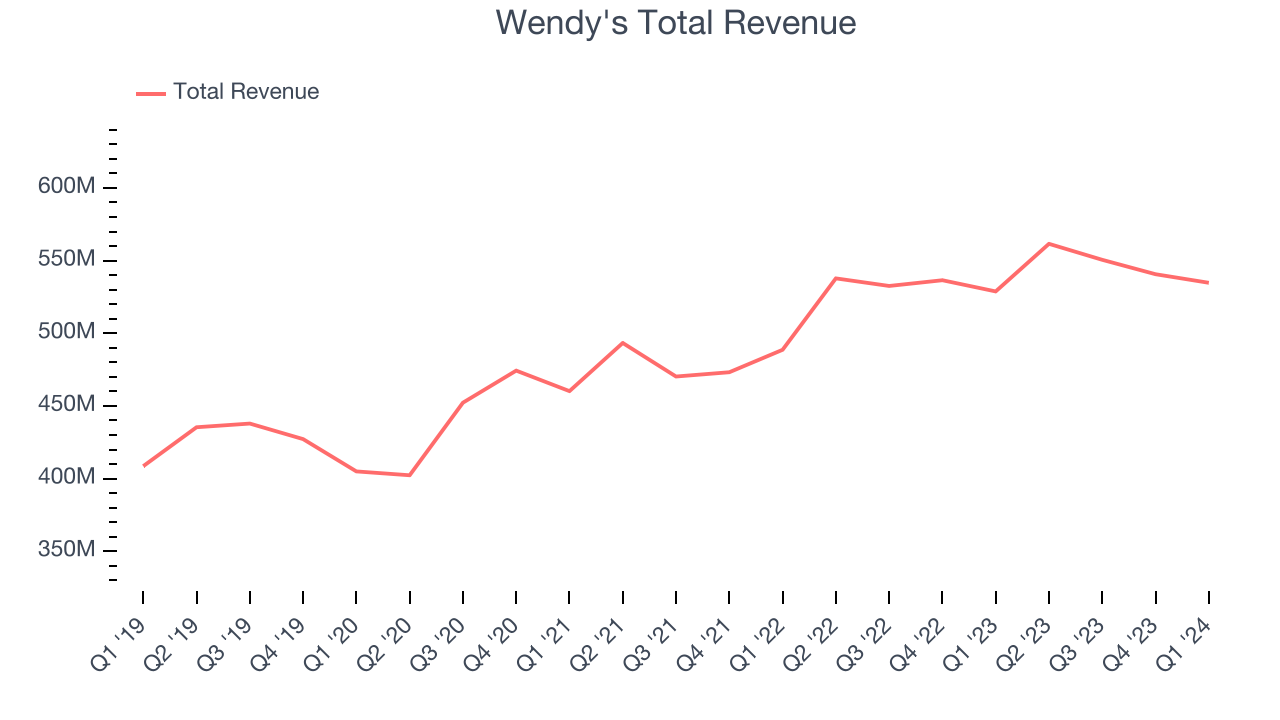
This quarter, Wendy's revenue grew 1.1% year on year to $534.8 million, falling short of Wall Street's estimates. Looking ahead, Wall Street expects sales to grow 4.4% over the next 12 months, an acceleration from this quarter.
Same-Store Sales
Wendy's demand within its existing restaurants has generally risen over the last two years but lagged behind the broader sector. On average, the company's same-store sales have grown by 4.4% year on year. With positive same-store sales growth amid an increasing number of restaurants, Wendy's is reaching more diners and growing sales.
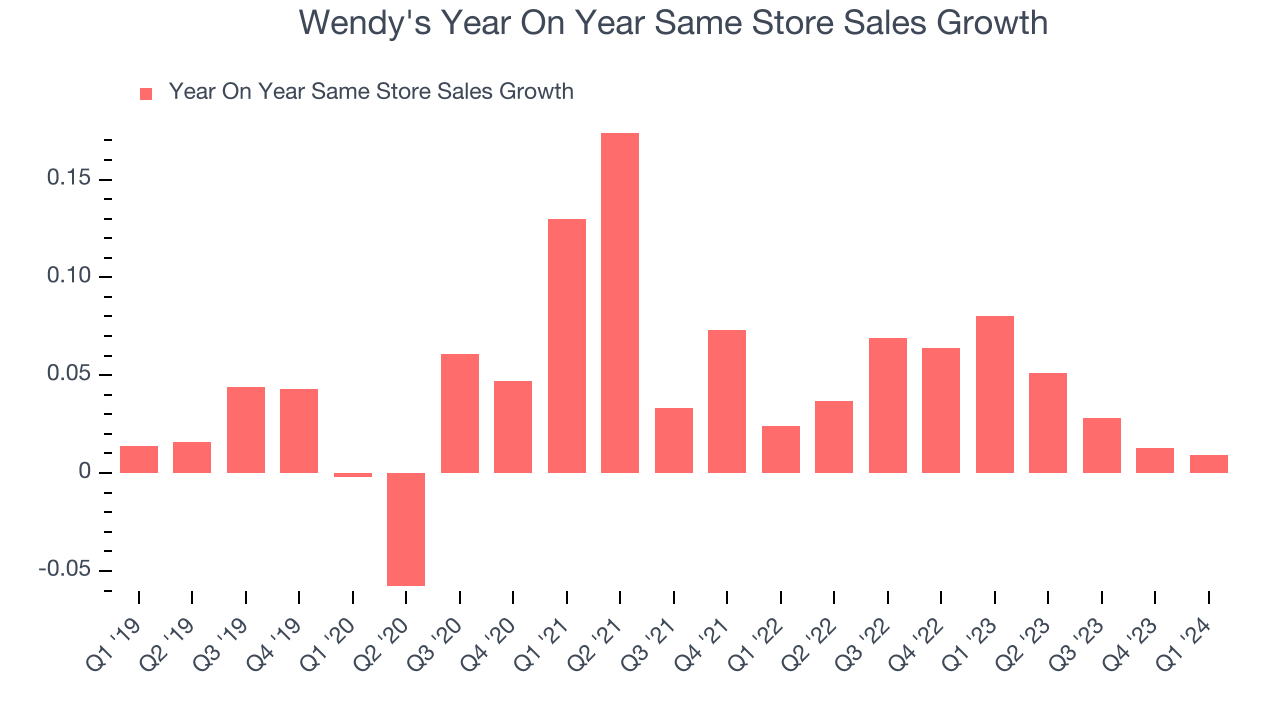
In the latest quarter, Wendy's year on year same-store sales were flat. By the company's standards, this growth was a meaningful deceleration from the 8% year-on-year increase it posted 12 months ago. We'll be watching Wendy's closely to see if it can reaccelerate growth.
Gross Margin & Pricing Power
We prefer higher gross margins because they not only make it easier to generate more operating profits but also indicate pricing power and differentiation, whether it be the dining experience or quality and taste of food.
Wendy's gross profit margin came in at 35.3% this quarter. in line with the same quarter last year. This means the company makes $0.35 for every $1 in revenue before accounting for its operating expenses.
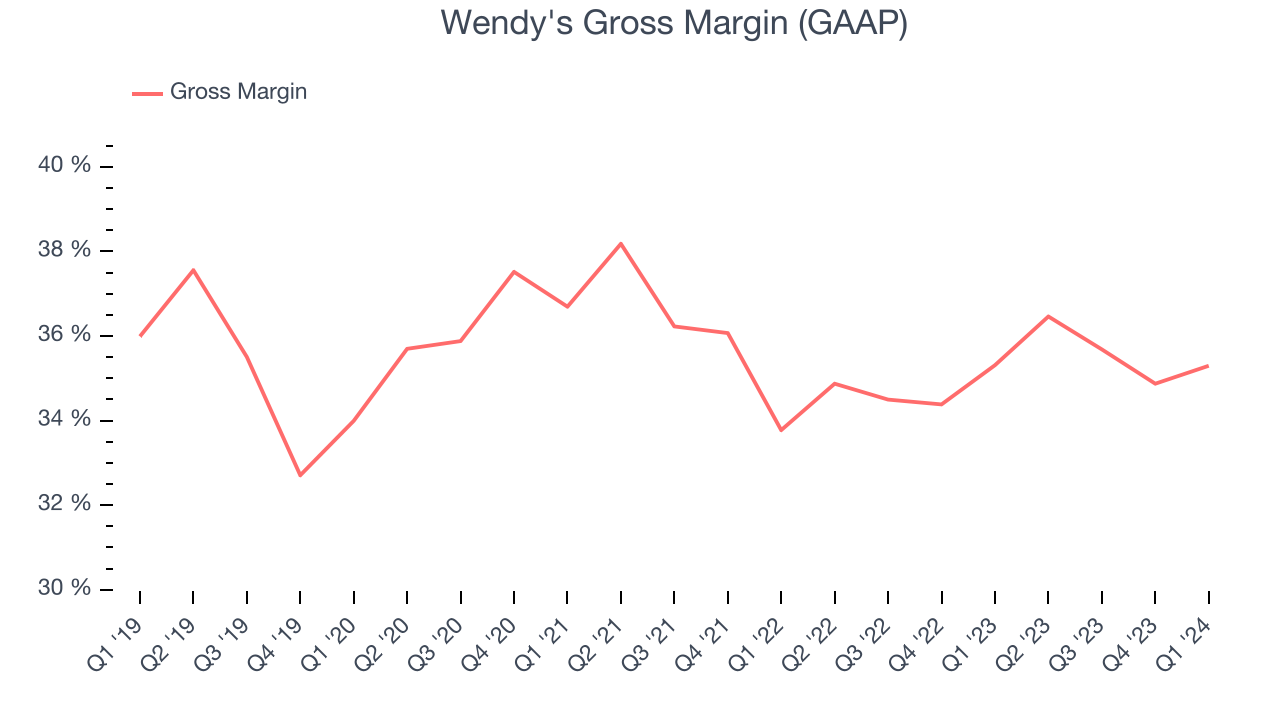
Wendy's has good unit economics for a restaurant company, giving it the opportunity to invest in areas such as marketing and talent to stay competitive. As you can see above, it's averaged a healthy 35.2% gross margin over the last two years. Its margin has also been trending up over the last 12 months, averaging 2.3% year-on-year increases each quarter. If this trend continues, it could suggest a less competitive environment where the company has better pricing power and more stable input costs (such as ingredients and transportation expenses).
Operating Margin
Operating margin is a key profitability metric for restaurants because it accounts for all expenses keeping the lights on, including wages, rent, advertising, and other administrative costs.
In Q1, Wendy's generated an operating profit margin of 15.2%, in line with the same quarter last year. This indicates the company's costs have been relatively stable.
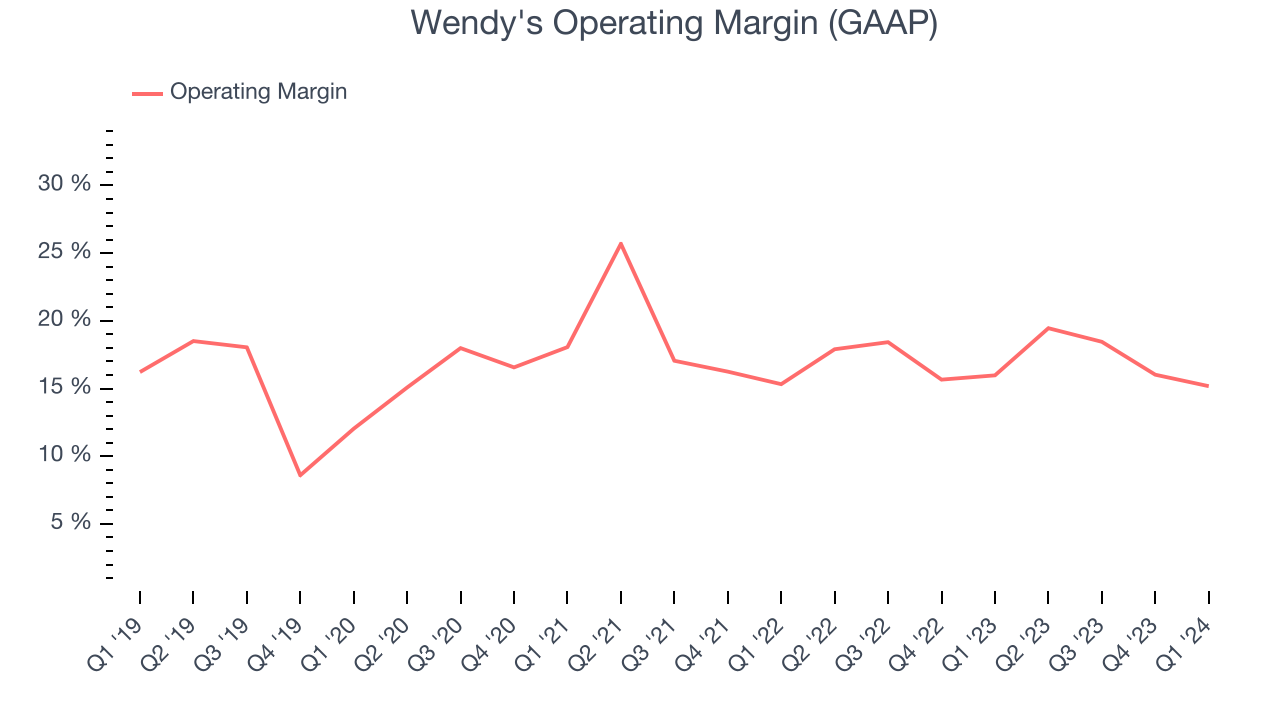 Zooming out, Wendy's has exercised operational efficiency over the last eight quarters. The company has demonstrated it can be one of the more profitable businesses in the restaurant sector, boasting an average operating margin of 17.2%. On top of that, its margin has remained more or less the same, highlighting the consistency of its business.
Zooming out, Wendy's has exercised operational efficiency over the last eight quarters. The company has demonstrated it can be one of the more profitable businesses in the restaurant sector, boasting an average operating margin of 17.2%. On top of that, its margin has remained more or less the same, highlighting the consistency of its business. EPS
Earnings growth is a critical metric to track, but for long-term shareholders, earnings per share (EPS) is more telling because it accounts for dilution and share repurchases.
In Q1, Wendy's reported EPS at $0.23, up from $0.21 in the same quarter a year ago. This print beat Wall Street's estimates by 8.1%.
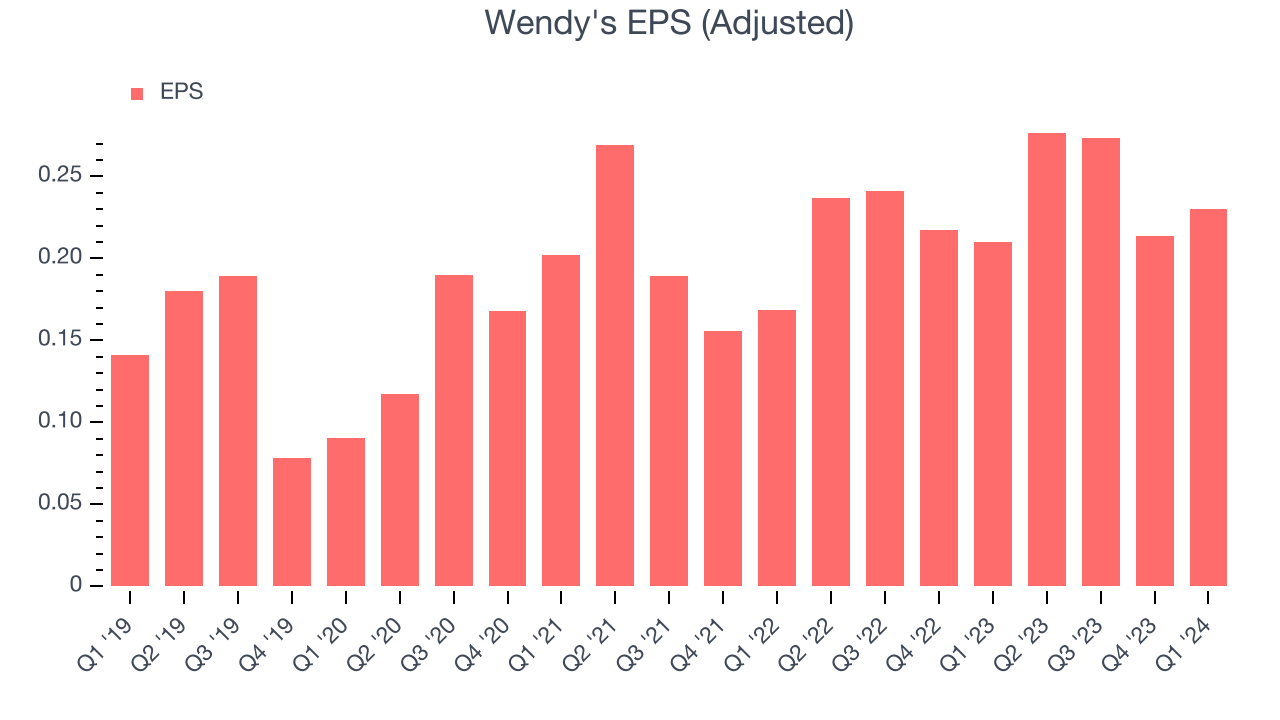
Wall Street expects the company to continue growing earnings over the next 12 months, with analysts projecting an average 2.7% year-on-year increase in EPS.
Cash Is King
Although earnings are undoubtedly valuable for assessing company performance, we believe cash is king because you can't use accounting profits to pay the bills.
Wendy's free cash flow came in at $82.63 million in Q1, up 103% year on year. This result represents a 15.5% margin.
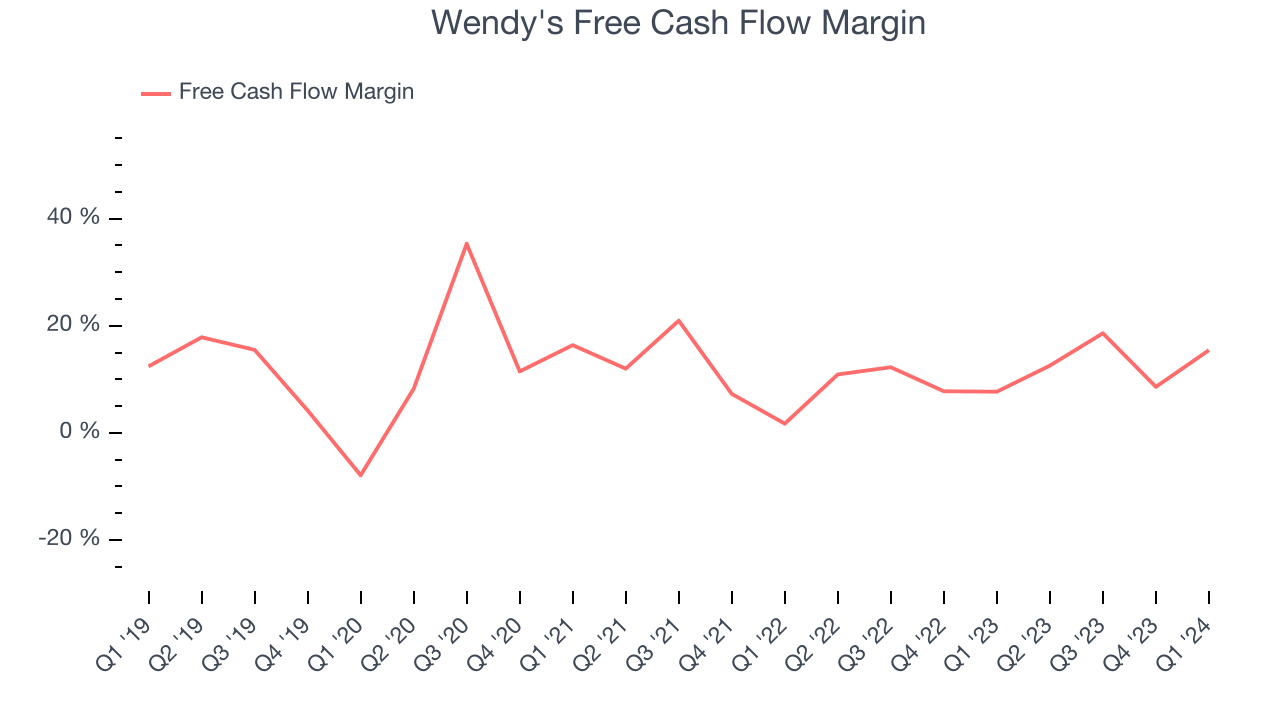
Over the last two years, Wendy's has shown strong cash profitability, giving it an edge over its competitors and the option to reinvest or return capital to investors while keeping cash on hand for emergencies. The company's free cash flow margin has averaged 11.8%, quite impressive for a restaurant business. Furthermore, its margin has averaged year-on-year increases of 4.1 percentage points. This likely pleases the company's investors.
Return on Invested Capital (ROIC)
EPS and free cash flow tell us whether a company was profitable while growing revenue. But was it capital-efficient? A company’s ROIC explains this by showing how much operating profit a company makes compared to how much money the business raised (debt and equity).
Although Wendy's hasn't been the highest-quality company lately, it historically did a solid job investing in profitable business initiatives. Its five-year average ROIC was 11%, higher than most restaurant companies.
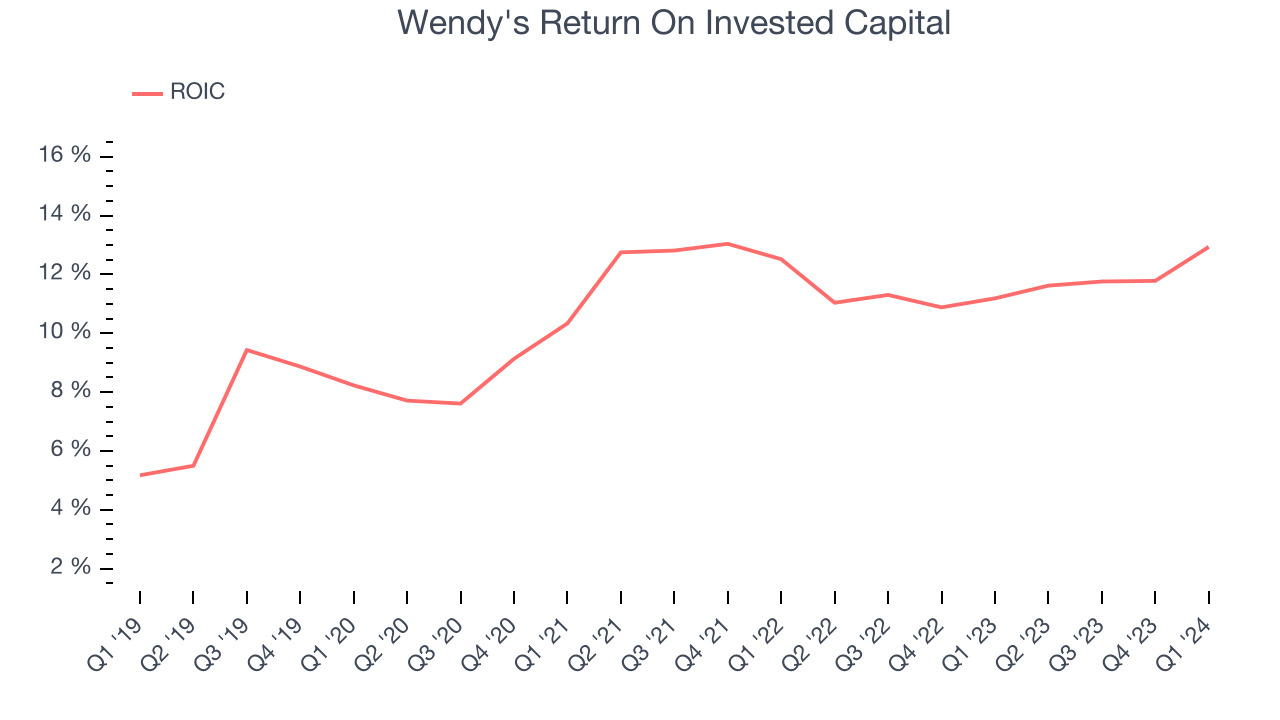
The trend in its ROIC, however, is often what surprises the market and drives the stock price. Over the last few years, Wendy's ROIC averaged 2.8 percentage point increases. This is a good sign, and if the company's returns keep rising, there's a chance it could evolve into an investable business.
Balance Sheet Risk
Debt is a tool that can boost company returns but presents risks if used irresponsibly.
Wendy's reported $498.3 million of cash and $2.76 billion of debt on its balance sheet in the most recent quarter. As investors in high-quality companies, we primarily focus on two things: 1) that a company's debt level isn't too high and 2) that its interest payments are not excessively burdening the business.
With $538.1 million of EBITDA over the last 12 months, we view Wendy's 4.2x net-debt-to-EBITDA ratio as safe. We also see its $122.9 million of annual interest expenses as appropriate. The company's profits give it plenty of breathing room, allowing it to continue investing in new initiatives.
Key Takeaways from Wendy's Q1 Results
We were impressed by how significantly Wendy's blew past analysts' gross margin expectations this quarter. We were also happy its EPS narrowly outperformed Wall Street's estimates. On the other hand, its revenue missed as its same-store sales growth came up short.
Looking ahead, Wendy's full-year EPS guidance was in line with estimates while its adjusted EBITDA and free cash flow came in slightly higher thanks to better-than-expected digital sales, which boost margins. Wendy's also said its breakfast menu items are seeing success, a key part of its strategy.
Overall, this quarter's results seemed fairly positive and shareholders should feel optimistic. The stock is flat after reporting and currently trades at $19.8 per share.
Is Now The Time?
Wendy's may have had a favorable quarter, but investors should also consider its valuation and business qualities when assessing the investment opportunity.
Wendy's isn't a bad business, but it probably wouldn't be one of our picks. Its revenue growth has been a little slower over the last five years, and analysts expect growth to deteriorate from here. And while its strong free cash flow generation allows it to invest in growth initiatives while maintaining an ample cash cushion, the downside is its projected EPS for the next year is lacking. On top of that, its mediocre same-store sales performance has been a headwind.
Wendy's price-to-earnings ratio based on the next 12 months is 19.2x. In the end, beauty is in the eye of the beholder. While Wendy's wouldn't be our first pick, if you like the business, the shares are trading at a pretty interesting price right now.
Wall Street analysts covering the company had a one-year price target of $20.84 per share right before these results (compared to the current share price of $19.80).
To get the best start with StockStory, check out our most recent stock picks, and then sign up to our earnings alerts by adding companies to your watchlist here. We typically have the quarterly earnings results analyzed within seconds of the data being released, and especially for companies reporting pre-market, this often gives investors the chance to react to the results before the market has fully absorbed the information.
